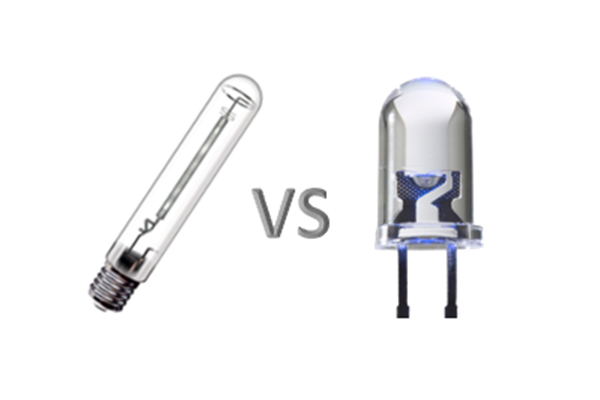Find out which is the most efficient lighting system between high pressure sodium lamps and LED lamps.

One of the main arguments for LED lighting is that it consumes two to three times less energy than High Pressure Sodium (HPS). But there are many additional advantages: intensity, efficiency, spectrum, thermal, variation, …
In its laboratory, Vegetal Grow Development has delved into the issue to ensure advanced results and correlate them to the plant field.
This test highlights the comparison between two luminaires: the 600 Watts HPS and the latest addition to the LUMIA range: the TOP MAX LUMIA 600W LED from Vegetal Grow Development (VGD).

Looking at the results, several points should be highlighted:
- At equivalent consumption the 600W led luminaire illuminates 20 to 40% more than two 600W HPS cumulated. That is to say a consumption of 60% to 80% less for the same flux on a crop. Take the example of a cucumber plant equipped with HPS, you have the choice either to divide up to three times the initial power consumption or to benefit from up to three times more light.
- HPS lamps emit mainly in a zone between 550nm and 630nm (corresponding to the yellow-orange zone of the visible spectrum) with a very low emission in the blue which is involved in the process of photosynthesis but also in the activation of photoreceptors mainly cryptochromes and phototropins.
- The red content of the HPS lamps is also low, even if some peaks of intensity are present. A thus partial activation of the phytochromes (photoreceptors of the red and far red) is obtained, as well as for the process of photosynthesis.
- The LED luminaires have spectra adapted to crops, whether in greenhouses or indoors, and can be used as a light supplement or as a total contribution (in the case of indoor crops).
- In a LED luminaire it is possible to choose the spectral bands used, this allows to activate mechanisms in the plants when desired. Use of specific bands for rooting, germination, flowering and other growth stages.
- Namely, HPS lamps lose on average 30% of their intensity after 3,000 hours of operation compared to 30,000 hours for LED lamps.
- The thermal delta is large enough to be compensated by more efficient heating systems (Watts/Joule) so it is a good mistake to keep HPS lights to replace heating. The study of a recognized Dutch university mentions that the use of LED lighting in the cultivation of grape tomatoes would reduce the overall electricity consumption by 15%.
- By reducing the number of HPS lamps in a greenhouse, thanks to the performance of LUMIA LED lighting, the shadow cast by HPS lamps can be reduced. Thus, the performance of current LED technology allows the HPS luminaires to be varied to date
Conclusion
For the same intensity (µmol/m²/s or lux) captured by a plant, HPS lamps consume more, are less efficient with a spectrum less optimized for photosynthesis. LED luminaires inevitably have more positive points compared to HPS lamps, but the question of price remains, where HPS lamps are still the winners. In our cities and in our homes we have passed the milestone of energy-efficient SLR and tomorrow what are we going to do for our crops?
It’s up to you to make up your mind based on the results.
Do you have any questions? Do you need more information about our trials? Request a test?
Contact us : contact@vgd-led.com



